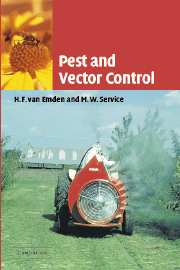Book contents
- Frontmatter
- Contents
- Preface
- 1 Man and insects
- 2 The causes of pest and vectored disease outbreaks
- 3 Insecticides and their formulation
- 4 Application of insecticides
- 5 Problems with insecticides
- 6 Environmental/cultural control
- 7 Biological control
- 8 Insect pathogens
- 9 Genetic control
- 10 Pheromones
- 11 Plant and host resistance
- 12 Other control measures and related topics
- 13 Pest and vector management
- Appendix of names of some chemicals and microbials used as pesticides
- References
- Index
4 - Application of insecticides
Published online by Cambridge University Press: 03 December 2009
- Frontmatter
- Contents
- Preface
- 1 Man and insects
- 2 The causes of pest and vectored disease outbreaks
- 3 Insecticides and their formulation
- 4 Application of insecticides
- 5 Problems with insecticides
- 6 Environmental/cultural control
- 7 Biological control
- 8 Insect pathogens
- 9 Genetic control
- 10 Pheromones
- 11 Plant and host resistance
- 12 Other control measures and related topics
- 13 Pest and vector management
- Appendix of names of some chemicals and microbials used as pesticides
- References
- Index
Summary
Introduction
The subject of pesticide application involves some really fascinating topics such as the fluid kinetics of droplet production and the engineering aspects of spray outlets (nozzles) and pressure sources (pumps). Much of this, however, lies outside the scope of this book, and readers are referred to Matthews (2000) for an excellent and well-illustrated account.
Formulation and the method of application can have almost greater influence on the efficiency and selectivity of kill than the choice of active ingredient. How these variables may be manipulated so that the pesticide application is less damaging to natural enemies is discussed in Chapter 13. It is a long, long way in biological terms from the emission of pesticide from a machine to achieving kill of a pest. The first problem is to get the right amount of chemical onto the target. There can be many targets. Plant surfaces are not only crops or competitive weeds; pesticides may also be sprayed on uncultivated land. In the past blanket spraying of vegetation, especially riverine vegetation, with residual insecticides to kill the tsetse fly vectors of both human trypanosomiasis (sleeping sickness) and animal trypanosomiasis (nagana) which can devastate the livestock industry in sub-Saharan Africa, has been commonly practised. Before the persistence of DDT in the environment was recognized (see Chapter 5), hedgerows adjacent to crops were sprayed to kill roosting cabbage and carrot root flies (Delia radicum and Psila rosae respectively).
- Type
- Chapter
- Information
- Pest and Vector Control , pp. 77 - 106Publisher: Cambridge University PressPrint publication year: 2004



